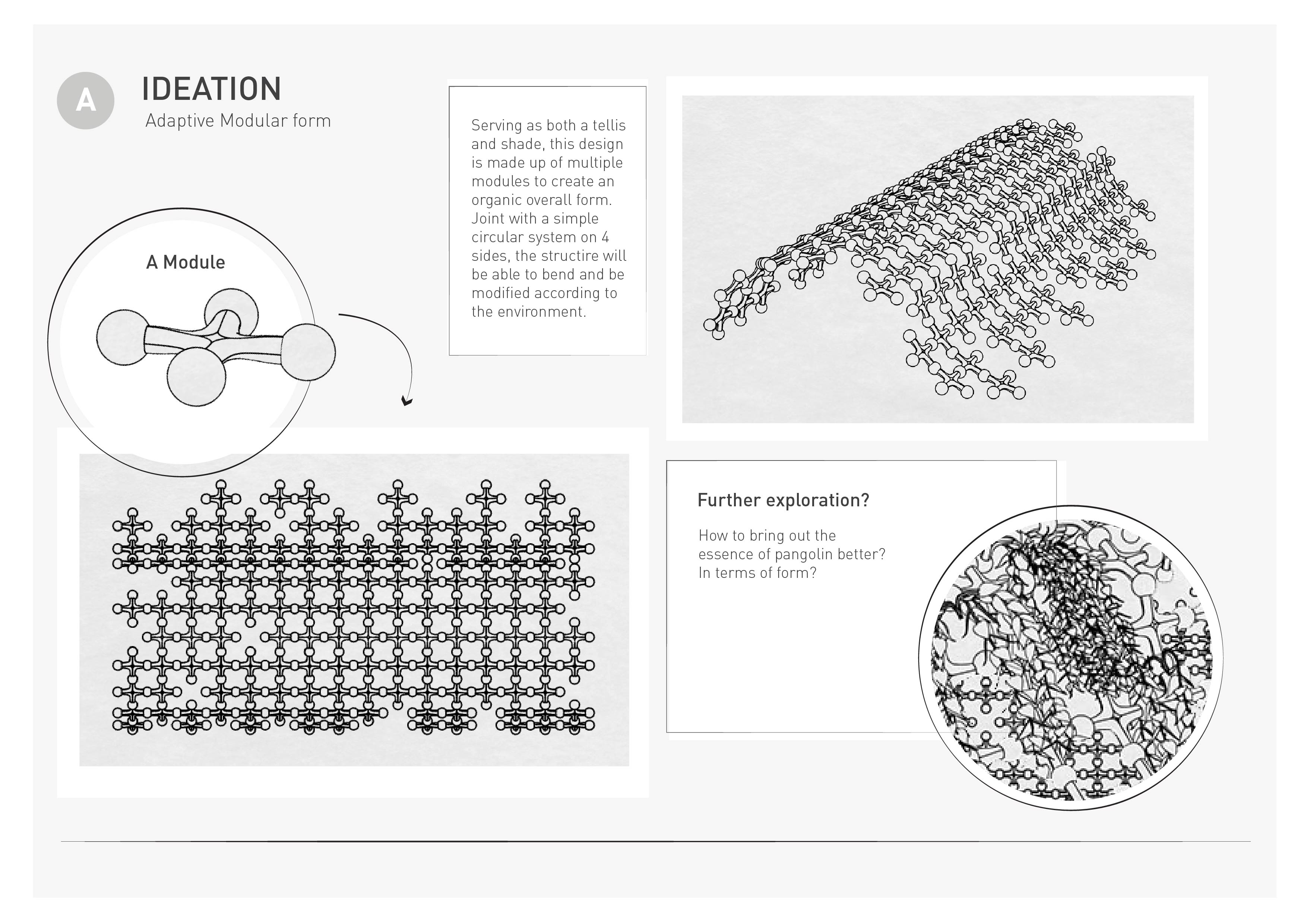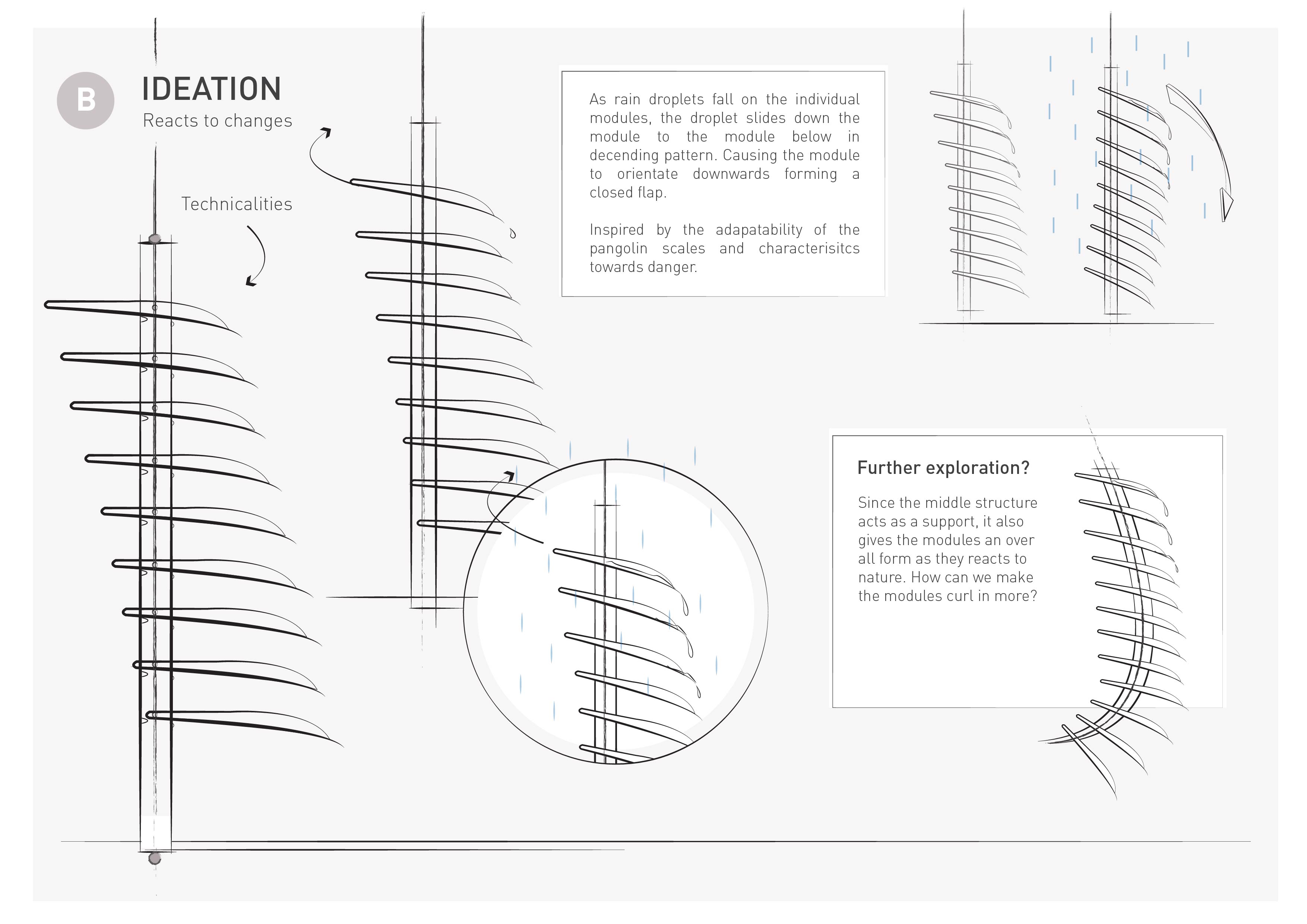Ideation
Fiona x Shanelle
Feedbacks gathered the last session:
- What is the overall form of the structure? Shade, trellis and pangolin-inspired form, are all three combining well? Which one is more conceptually relevant, more representative of NTU, more promising of good results?
- A function is defined by its creator and you define it. The function doesn’t necessarily have to be solely functional and practical. For instance, the main purpose of a vase isn’t to hold flowers but to serve as a decorative piece.
- Focus on bringing out the essence of the pangolin if that’s what you all would like to remind people of, that pangolin resides here. For instance, translating the adaptability characteristic of the pangolin scales into a sculpture, using a singular modular to create an organic form.
Questions we asked ourselves:
- Perhaps we could look into unique key characteristics of pangolin to bring out the essence of pangolin? (Based on the feedback previously, modular repetitive structures are seen everywhere in nature organisms so what’s so unique only to pangolin itself?)
- How can we integrate nature? Perhaps such that when a natural phenomenon meets the man-made structure (our sculpture) it will create a movement that mimics the adaptability nature of the pangolin scales when in an encounter with their predators. (We are in the midst of researching on materials that react to nature. By nature, we meant water, heat, light or touch etc.)
More Design references
{Note: References might not be directly related to what we plan to do}
Water Pachinko – Kenya Hara
Designed by Japanese designer, Kenya Hara, these rolling water droplets on the table works like Japanese pinball, also known as pachinko.The spherical water droplets silently navigate their way down the complex white paper structure coated with super-hydrophobic substances.The numerous water droplets may divide at one point, unite at another or fall into the hole, thereby creating a new experience and excitement for the senses.
Water Reactive Architectural Surface – Chao Chen
Designed by Royal College of Art design student, Chao Chen, this wood laminate material bends in response to the humidity in the atmosphere, rain, and moisture. This biomimetic material is able to change its shape without using any electric system or mechanical structure. The individual tiles curl and open in dry weather to let the light and breezes in and flatten out when it rains to protect the occupants.
Ideation
Direction 1
A quick recap of our previous post, we wanted to design a sculpture that functions as both a trellis and shade, balancing the positive and negative space with a suitable modular structure. The diagram below shows one of our form explorations for our sculpture. The skeleton structure is built using a singular module that eventually forms to bend in an organic shape. With this characteristic of adaptability, the sculpture could be placed anywhere in school as it can be bent and adjusted according to the surroundings.
Direction 2
What are other ways to show the relationship between nature and man-made structure? Keeping in mind that nature ain’t just greeneries around us but climate, humidity and weather such as sunlight and rain are considered as nature as well.
When in contact with man-made structure, can a natural phenomenon create an interaction that mimics the curling up dynamism of a pangolin?
As rain droplets falls on the structure, the weight of the droplets orientate the module, the droplet slides down to one end and landed on the next module right below, slowly descending and making its way down. The interaction between the rain and each piece of modules together formed a reaction in response to intensity of the downpour – showing progression of the rain.
Additionally, the structure comes with an embedded stopper in the supporting rib to prevent the modules from rotating in another direction. Each module are arranged in a descending manner such to control the flow of the water to reflect the integrated and collective effort of each module contributing to the reaction in response to the rain droplets.
Other possible Direction
What about the interaction of material and nature?
As inspired by how pangolin curls up when faced with threat,
We have been looking into other possible methods of creating the rolling and unrolling dynamics through the interaction of material and nature. – Of how material behaves when interacted with nature. We are reminded of how paper curls up due to the swelling when it comes in contact of water and went into researching more about it.
We came across an article that shares:
“how tracing paper curls up when placed on the surface of the water. Over time, the swelling front of the paper that comes in contact with water propagates through the thickness of the paper, the paper gradually uncurls itself and eventually straightens out.”
We gave it a try! We felt that the drawback in regards to paper was however the durability and maintenance of it, be it for wet/dry conditions. And the paper doesn’t curls back when it dry unless its fully drenched.

We further researched into other materials and found something interesting that we could possibility look into! All of us are aware that a certain kind and thickness of metal/wood reacts to climate conditions. While researching, we came across the possibilities of using thermal expansion to create interactions.
Such as Bimetal aka thermostatic metal. So,what’s a bimetal?
“Bimetals are hence layered metallic composites, most common in the form of strips or sheets that consist of at least two tightly bonded components with differing thermal expansion rates.”
| “Since, when heated, one layer expands more than the other the flat strip is forced to bend one way, and towards the opposite direction when cooled back below its initial temperature. The larger the difference in thermal expansion, the larger is the resulting mechanical displacement.” |
While researching on the feasibility, we noticed that there are some projects out there which uses bimetal coils to create movements via temperature such as the following:
The metal strips curl upwards when heated, allowing air to pass through. The full project description can also be seen here.
For this direction, we are still in the midst of figuring it out, we will have to get the materials and test it out via sunlight to see if it works before we work out on the possible structure to supports the entire reaction.
References
https://inhabitat.com/astonishing-water-sensitive-building-material-acts-just-like-pine-cones/
https://www.archdaily.com/887326/digital-manufacturing-to-experience-real-scale-architecture-quickly-and-with-limited-resources
https://designingthinking.wordpress.com/2008/08/27/01-nature-water-pachinko-by-kenya-hara/
https://bott2013studio.wordpress.com/2013/09/12/kenya-hara-water-pachinko/




You need to decide one direction and proceed with it.
I wouldn’t recommend the bimetal elements, they required a lot of experimentation and you have no time for it.
shade and trellis are fine but so far the proposal you’re showing up here is shapeless, it’s a module that can be assembled. You have to design something with that modules.
we want to see your proposal: dimensions, materials, find a location and motivate your choice. The installation should be relevant, it should dialogue with the surrounding environment and with the users, what the people is supposed to see-touch-use-enjoy-remember…?
Can you show some progress by next week? Please, no writings but drawings